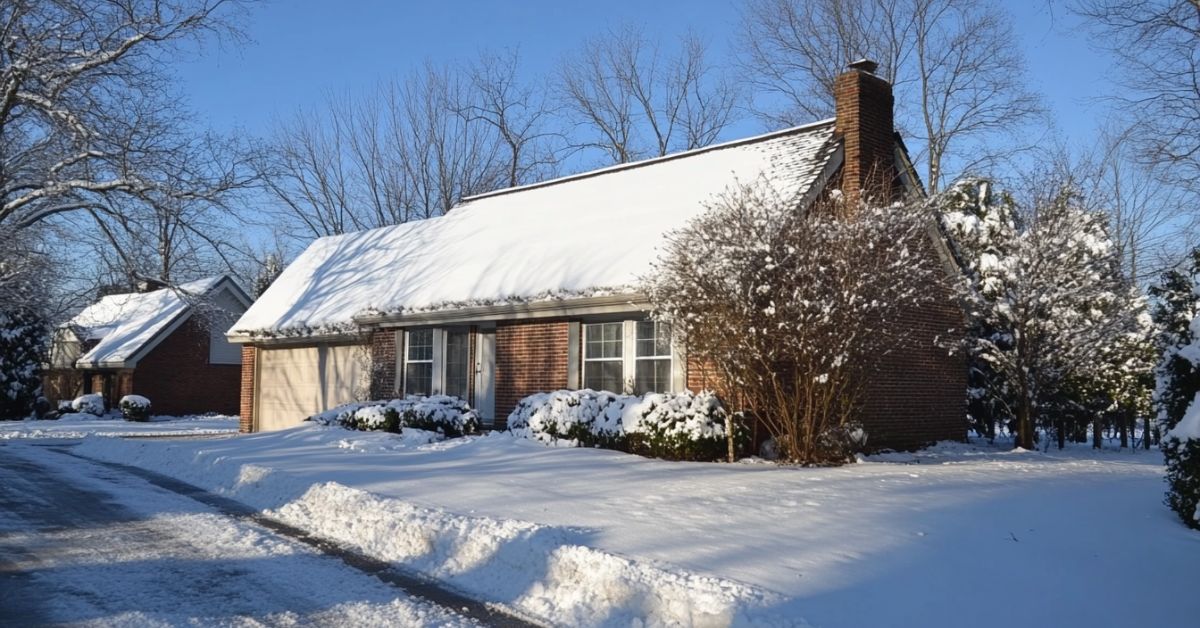
April 4, 2025
Best Roof Materials for Freeze-Thaw Conditions in North Hampton
Nestled in the heart of South St. Louis, North Hampton (ZIP code 63139) is known for its charming brick homes, family-friendly vibe, and proximity to Tower Grove Park. But while the neighborhood offers plenty of curb appeal, homeowners here face a unique roofing challenge: the freeze-thaw cycle.
Each year, North Hampton experiences drastic temperature shifts, especially in winter and early spring. These swings cause roofing materials to expand and contract—leading to cracks, leaks, and premature wear if the wrong materials are used. In this blog, we’ll explore why freeze-thaw resistance matters and the best roofing materials for North Hampton homes based on insights from the St. Louis climate-focused roofing report.
🌡️ What is the Freeze-Thaw Cycle and Why Does It Matter?
The freeze-thaw cycle occurs when moisture seeps into roofing materials or small cracks, then freezes as temperatures drop below 32°F. As water turns into ice, it expands—widening gaps, lifting shingles, and weakening the structure. When temperatures rise again, the ice melts, often resulting in water penetration and roof damage.
In neighborhoods like North Hampton, where homes face:
- Frequent overnight freezing and daytime thawing in winter,
- Moisture-heavy snowstorms, and
- Spring rainstorms right after a deep freeze,
the cycle can be particularly harsh.
That’s why choosing roofing materials with high thermal stability—i.e., the ability to resist damage from temperature-related expansion and contraction—is essential for long-term protection.
🏡 Best Roofing Materials for Freeze-Thaw Conditions in North Hampton
Based on data from the roofing report and what we know about local climate and home styles, here are the top recommended materials:
1. Architectural Asphalt Shingles (with Reinforced Fiberglass)
Why they work:
These shingles are a step up from traditional 3-tab shingles, offering greater thickness, flexibility, and impact resistance. With fiberglass reinforcement and laminated construction, they handle St. Louis winters better than basic shingles.
Benefits:
✅ Affordable and widely available
✅ Withstand moderate hail and freezing rain
✅ Layered design minimizes curling and cracking
Family First Pro Tip: Choose Class 4 impact-rated shingles, which perform better in freeze-thaw and hail conditions common in North Hampton.
2. Metal Roofing (Steel or Aluminum)
Why it works:
Metal roofing is highly resistant to freeze-thaw damage because it doesn’t absorb water. It expands and contracts without cracking, and snow/ice slides off easily, preventing ice dam formation.
Benefits:
✅ Excellent thermal flexibility
✅ Long lifespan (40–70 years)
✅ Great for shedding snow and rain
✅ Energy efficient in all seasons
Caution: Proper underlayment and installation are essential to prevent condensation in the attic, which is a risk if ventilation is poor.
3. Slate Roofing (Natural or Synthetic)
Why it works:
Slate is one of the most durable materials in cold climates, naturally resistant to moisture and temperature fluctuations. It’s dense, non-porous, and can last over a century if installed correctly.
Benefits:
✅ Extreme durability under freeze-thaw conditions
✅ Fireproof and waterproof
✅ High-end aesthetic ideal for North Hampton’s historic homes
Caution: Real slate is heavy—your roof structure must be evaluated. Synthetic slate (rubber or polymer-based) mimics the look but is lighter and more affordable, with excellent freeze-thaw resistance.
4. Modified Bitumen (for Flat or Low-Slope Roofs)
Why it works:
For homes or additions with flat roofs, modified bitumen systems offer flexible, rubberized protection. Their ability to expand and contract without cracking makes them ideal for cold, shifting climates.
Benefits:
✅ Durable and flexible under extreme temperature swings
✅ Can be installed with cold adhesives (no torching needed)
✅ Great for small urban roofs and porches
Local Tip: In North Hampton, many garages and porches have low-slope roofs. Modified bitumen is an excellent option for those surfaces.
🧱 What Roofing Materials to Avoid in Freeze-Thaw Zones
Some materials don’t hold up well in St. Louis’ freeze-thaw cycle:
- ❌ Wood Shingles/Shakes – Prone to moisture absorption, rot, and cracking
- ❌ Basic 3-Tab Shingles – Less durable, more likely to curl or blister under temperature swings
- ❌ Unsealed Flat Roofs – Without proper sealing and drainage, flat roofs can trap water and form ice dams or ponding issues
🛠️ Installation & Ventilation Matter, Too
Even the best materials can fail if the roof isn’t installed correctly. In freeze-thaw climates, the underlayment, flashing, ventilation, and insulation must work together to prevent:
- Moisture from getting trapped under shingles
- Heat from escaping into the attic and causing ice dams
- Condensation that leads to mold or wood rot
At Family First Exteriors, we ensure every North Hampton roofing project includes proper ice & water shields, ridge ventilation, and cold-climate best practices to help your roof last decades.
🧰 Final Thoughts: Build a Roof That Handles St. Louis Winters
If you live in North Hampton, your roof needs to be ready for repeated freeze-thaw cycles, intense UV exposure, hail, and heavy rains. Choosing the right material is step one—but partnering with a roofer who understands St. Louis’ weather is just as important.
Why Choose Family First Exteriors?
🏠 Local Expertise – We know the patterns of St. Louis winters and how they impact roofing materials.
🔨 Certified Installers – We use manufacturer-approved techniques and ice-barrier systems.
📍 Neighborhood Experience – We’ve worked on many homes right here in North Hampton.
🔍 Free Inspections & Honest Assessments – We’ll tell you if a repair is enough—or if it’s time to upgrade.
📞 Ready for a Roof That Lasts All Year?
Contact Family First Exteriors for a free roof inspection in North Hampton. Let us help you choose the best freeze-thaw-resistant materials so your home is protected, no matter the season.
📍 Serving St. Louis neighborhoods with roofing systems built for Midwest weather—and built to last.
